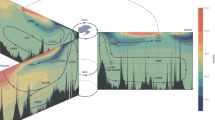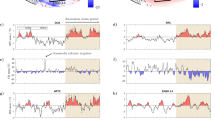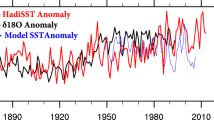Abstract
During 2013–2020, the northern tropical Pacific Ocean (NTPO, 5° N–20° N) experienced a persistent surface warming of over 0.5 °C. This warming was accompanied by a consecutively low surface chlorophyll (SChl). Here, we combined observations with ocean general circulation model experiments to determine how the interplays between the North Pacific meridional mode (NPMM) and multi-year El Niño events jointly led to this persistent surface warming. The warm phase of NPMM (+) excited an anticyclonic circulation in the NTPO, which caused surface warming and enhanced the upper-ocean stratification in the western sector (160° E–150° W) and also deepened the thermocline in the eastern sector (150° W–110° W), resulting in a widespread decline in SChl. The NPMM (+) also triggered El Niño events during the subsequent winter, further decreasing the negative SChl anomalies by weakening the surface ocean current. Subsequently, two persistent El Niño events happened in succession (2014–2016 and 2018–2020), which acted to accelerate the decline in SChl by 2020. These results help to illustrate the effects of extratropical-tropical interactions on the compound physical-biological extremes under the global warming scenario.
















Similar content being viewed by others
Data availability
We thank the GlobColor Project at the CMEMS website (https://doi.org/10.48670/moi-00281) supplied SChl data, the National Oceanic and Atmospheric Administration (NOAA)/National Centers for Environmental Information (NCEI) provided ERSSTv5 data, (https://www.ncei.noaa.gov/access/metadata/landing-page/bin/iso?id=gov.noaa.ncdc:C00927#Documentation), NOAA/Physical Science Laboratory (PSL) provided GODAS data (https://psl.noaa.gov/data/gridded/data.godas.html), National Centers for Environmental Prediction (NCEP) (https://psl.noaa.gov/data/gridded/data.ncep.reanalysis.html) and ECMWF Reanalysis v5 (ERA5) provided atmospheric reanalysis data (https://www.ecmwf.int/en/forecasts/dataset/ecmwf-reanalysis-v5), Met Office provided EN4 data (https://www.metoffice.gov.uk/hadobs/en4/), Copernicus Marine Environment Monitoring Service (CMEMS) provided altimeter satellite gridded data and hindcast biogeochemical simulation data (https://data.marine.copernicus.eu/products), and Oregon State University provided net primary productivity data (https://sites.science.oregonstate.edu/ocean.productivity/). We also thank the climate modeling groups (listed in Table S1) for producing and making available their model outputs, and the Earth System Grid Federation (ESGF) for archiving the CMIP6 data and providing access; CMIP6 outputs were downloaded from the ESGF-DOE/LLNL node by https://esgf-node.llnl.gov/search/cmip6/. We also thank the Max Planck Institute for Meteorology (MPI-M) for developing the Climate Data Operator (CDO) software version 1.6.9 at http://mpimet.mpg.de/cdo.
References
Amaya DJ (2019) The Pacific meridional mode and ENSO: a review. Curr Clim Chang Reports 5:296–307. https://doi.org/10.1007/s40641-019-00142-x
Amaya DJ, Miller AJ, Xie SP, Kosaka Y (2020) Physical drivers of the summer 2019 North Pacific marine heatwave. Nat Commun 11:1–9. https://doi.org/10.1038/s41467-020-15820-w
Arteaga L, Pahlow M, Oschlies A (2014) Global patterns of phytoplankton nutrient and light colimitation inferred from an optimality-based model. Global Biogeochem Cycles 28:648–661. https://doi.org/10.1002/2013GB004668
Aumont O, Bopp L (2006) Globalizing results from ocean in situ iron fertilization studies. Global Biogeochem Cycles 20:1–15. https://doi.org/10.1029/2005GB002591
Aumont O, Ethé C, Tagliabue A et al (2015) PISCES-v2: an ocean biogeochemical model for carbon and ecosystem studies. Geosci Model Dev 8:2465–2513. https://doi.org/10.5194/gmd-8-2465-2015
Behringer DW (2007) The global ocean data assimilation system (GODAS) at NCEP. Preprints, 11th symp. on integrated observing and assimilation systems for atmosphere, oceans, and land surface, San Antonio, TX, Amer. Meteor. Soc., 3.3. http://ams.confex.com/ams/87ANNUAL/techprogram/paper_119541.htm
Browning TJ, Moore CM (2023) Global analysis of ocean phytoplankton nutrient limitation reveals high prevalence of co-limitation. Nat Commun 14:1–12. https://doi.org/10.1038/s41467-023-40774-0
Browning TJ, Saito MA, Garaba SP et al (2023) Persistent equatorial Pacific iron limitation under ENSO forcing. Nature. https://doi.org/10.1038/s41586-023-06439-0
Burger FA, Terhaar J, Frölicher TL (2022) Compound marine heatwaves and ocean acidity extremes. Nat Commun 13:4722. https://doi.org/10.1038/s41467-022-32120-7
Cai W, Borlace S, Lengaigne M et al (2014) Increasing frequency of extreme El Niño events due to greenhouse warming. Nat Clim Chang 5:1–6. https://doi.org/10.1038/nclimate2100
Cai W, Yang K, Wu L et al (2021) Opposite response of strong and moderate positive Indian Ocean Dipole to global warming. Nat Clim Chang 11:27–32. https://doi.org/10.1038/s41558-020-00943-1
Chang P, Zhang L, Saravanan R et al (2007) Pacific meridional mode and El Niño–Southern oscillation. Geophys Res Lett 34:1–5. https://doi.org/10.1029/2007GL030302
Chavez FP, Strutton PG, McPhaden MJ (1998) Biological-physical coupling in the central equatorial Pacific during the onset of the 1997–98 El Niño. Geophys Res Lett 25:3543–3546. https://doi.org/10.1029/98GL02729
Chen H, Wang Y, Xiu P et al (2023) Combined oceanic and atmospheric forcing of the 2013/14 marine heatwave in the northeast Pacific. Npj Clim Atmos Sci 6:3. https://doi.org/10.1038/s41612-023-00327-0
Cheng L, von Schuckmann K, Abraham JP et al (2022) Past and future ocean warming. Nat Rev Earth Environ 3:776–794. https://doi.org/10.1038/s43017-022-00345-1
Christian JR, Verschell MA, Murtugudde R et al (2001) Biogeochemical modelling of the tropical Pacific Ocean. I: seasonal and interannual variability. Deep Sea Res Part II Top Stud Oceanogr 49:509–543. https://doi.org/10.1016/S0967-0645(01)00110-2
Coralie P, Camille S, Julien P, Marie D (2019) Quality information document: global production centre GLOBAL_REANALYSIS_BIO_001_029
Cronin MF, Pelland NA, Emerson SR, Crawford WR (2015) Estimating diffusivity from the mixed layer heat and salt balances in the North Pacific. J Geophys Res Ocean 120:7346–7362. https://doi.org/10.1002/2015JC011010
Di Lorenzo E, Mantua N (2016) Multi-year persistence of the 2014/15 North Pacific marine heatwave. Nat Clim Chang 6:1042–1047. https://doi.org/10.1038/nclimate3082
Ding R, Tseng Y, Di Lorenzo E et al (2022) Multi-year El Niño events tied to the North Pacific Oscillation. Nat Commun 13:3871. https://doi.org/10.1038/s41467-022-31516-9
Doney SC, Ruckelshaus M, Emmett Duffy J et al (2012) Climate change impacts on marine ecosystems. Ann Rev Mar Sci 4:11–37. https://doi.org/10.1146/annurev-marine-041911-111611
Duan J, Li Y, Cheng L et al (2023) Heat storage in the upper Indian ocean: the role of wind-driven redistribution. J Clim 36(7):2221–2242. https://doi.org/10.1175/JCLI-D-22-0534.1
Gnanadesikan A, Anderson WG (2009) Ocean water clarity and the ocean general circulation in a coupled climate model. J Phys Oceanogr 39:314–332. https://doi.org/10.1175/2008JPO3935.1
Good SA, Martin MJ, Rayner NA (2013) EN4: quality controlled ocean temperature and salinity profiles and monthly objective analyses with uncertainty estimates. J Geophys Res Ocean 118:6704–6716. https://doi.org/10.1002/2013JC009067
Gruber N, Boyd PW, Frölicher TL, Vogt M (2021) Biogeochemical extremes and compound events in the ocean. Nature 600:395–407. https://doi.org/10.1038/s41586-021-03981-7
Guan C, Wang X, Yang H (2023) Understanding the development of the 2018/19 Central Pacific El Niño. Adv Atmos Sci 40:177–185. https://doi.org/10.1007/s00376-022-1410-1
Hersbach H, Bell B, Berrisford P et al (2020) The ERA5 global reanalysis. Q J R Meteorol Soc 146:1999–2049. https://doi.org/10.1002/qj.3803
Hu S, Fedorov AV (2017) The extreme El Niño of 2015–2016 and the end of global warming hiatus. Geophys Res Lett 44:3816–3824. https://doi.org/10.1002/2017GL072908
Huang B, Thorne PW, Banzon VF et al (2017) Extended reconstructed Sea surface temperature, Version 5 (ERSSTv5): upgrades, validations, and intercomparisons. J Clim 30:8179–8205. https://doi.org/10.1175/JCLI-D-16-0836.1
Jia F, Cai W, Gan B et al (2021) Enhanced North Pacific impact on El Niño/Southern Oscillation under greenhouse warming. Nat Clim Chang. https://doi.org/10.1038/s41558-021-01139-x
Lee K-W, Yeh S-W, Kug J-S, Park J-Y (2014) Ocean chlorophyll response to two types of El Niño events in an ocean-biogeochemical coupled model. J Geophys Res Ocean 119:933–952. https://doi.org/10.1002/2013JC009050
Lim HG, Park JY, Kug JS (2018) Impact of chlorophyll bias on the tropical Pacific mean climate in an earth system model. Clim Dyn 51:2681–2694. https://doi.org/10.1007/s00382-017-4036-8
Lim H, Dunne JP, Stock CA et al (2022) Oceanic and atmospheric drivers of post-El-Niño chlorophyll rebound in the equatorial Pacific. Geophys Res Lett. https://doi.org/10.1029/2021GL096113
Liu H, Nie X, Cui C, Wei Z (2023) Compound marine heatwaves and low sea surface salinity extremes over the tropical Pacific Ocean. Environ Res Lett 29:465705. https://doi.org/10.1088/1748-9326/acd0c4
Madec G (2014) “NEMO ocean engine” (Draft edition r5171) Note du Pôle de modélisation de l’Institut Pierre-Simon Laplace
Maes C (2000) Salinity variability in the equatorial Pacific Ocean during the 1993–98 period. Geophys Res Lett 27:1659–1662. https://doi.org/10.1029/1999GL011261
Maritorena S, d’Andon OHF, Mangin A, Siegel DA (2010) Merged satellite ocean color data products using a bio-optical model: characteristics, benefits and issues. Remote Sens Environ 114:1791–1804. https://doi.org/10.1016/j.rse.2010.04.002
Messié M, Chavez FP (2013) Physical-biological synchrony in the global ocean associated with recent variability in the central and western equatorial Pacific. J Geophys Res Ocean 118:3782–3794. https://doi.org/10.1002/jgrc.20278
Murtugudde RG, Signorini SR, Christian JR et al (1999) Ocean color variability of the tropical Indo-Pacific basin observed by SeaWiFS during 1997–1998. J Geophys Res Ocean 104:18351–18366. https://doi.org/10.1029/1999jc900135
Murtugudde R, Beauchamp J, McClain CR et al (2002) Effects of penetrative radiation of the upper tropical ocean circulation. J Clim 15:470–486. https://doi.org/10.1175/1520-0442(2002)015%3c0470:EOPROT%3e2.0.CO;2
Nakamura Y, Oka A (2019) CMIP5 model analysis of future changes in ocean net primary production focusing on differences among individual oceans and models. J Oceanogr 75:441–462. https://doi.org/10.1007/s10872-019-00513-w
Oliver ECJ, Benthuysen JA, Bindoff NL et al (2017) The unprecedented 2015/16 Tasman Sea marine heatwave. Nat Commun 8:16101. https://doi.org/10.1038/ncomms16101
Park J-Y, Kug J-S, Park J et al (2011) Variability of chlorophyll associated with El Niño-Southern Oscillation and its possible biological feedback in the equatorial Pacific. J Geophys Res 116:C10001. https://doi.org/10.1029/2011JC007056
Radenac M-H, Léger F, Singh A, Delcroix T (2012) Sea surface chlorophyll signature in the tropical Pacific during eastern and central Pacific ENSO events. J Geophys Res Ocean. https://doi.org/10.1029/2011JC007841
Schmeisser L, Bond NA, Siedlecki SA, Ackerman TP (2019) The role of clouds and surface heat fluxes in the maintenance of the 2013–2016 Northeast Pacific marine heatwave. J Geophys Res Atmos 124:10772–10783. https://doi.org/10.1029/2019JD030780
Seager R, Cane M, Henderson N et al (2019) Strengthening tropical Pacific zonal sea surface temperature gradient consistent with rising greenhouse gases. Nat Clim Chang 9:517–522. https://doi.org/10.1038/s41558-019-0505-x
Shchepetkin AF, McWilliams JC (2005) The regional oceanic modeling system (ROMS): a split-explicit, free-surface, topography-following-coordinate oceanic model. Ocean Model 9:347–404. https://doi.org/10.1016/j.ocemod.2004.08.002
Shi W, Wang M (2014) Satellite-observed biological variability in the equatorial Pacific during the 2009–2011 ENSO cycle. Adv Sp Res 54:1913–1923. https://doi.org/10.1016/j.asr.2014.07.003
Smale DA, Wernberg T, Oliver ECJ et al (2019) Marine heatwaves threaten global biodiversity and the provision of ecosystem services. Nat Clim Chang 9:306–312. https://doi.org/10.1038/s41558-019-0412-1
Smith KE, Burrows MT, Hobday AJ et al (2023) Biological impacts of marine heatwaves. Ann Rev Mar Sci 15:1–27. https://doi.org/10.1146/annurev-marine-032122-121437
Tian F, Zhang R-H, Wang X (2019) Factors affecting interdecadal variability of air–sea CO2 fluxes in the tropical Pacific revealed by an ocean physical–biogeochemical model. Clim Dyn 53(7–8):3985–4004. https://doi.org/10.1007/s00382-019-04766-5
Tian F, Zhang R-H, Wang X (2021a) Coupling ocean–atmosphere intensity determines ocean chlorophyll-induced SST change in the tropical Pacific. Clim Dyn 56:3775–3795. https://doi.org/10.1007/s00382-021-05666-3
Tian F, Zhang R-H, Wang X, Zhi H (2021b) Rectified effects of interannual chlorophyll variability on the tropical pacific climate revealed by a hybrid coupled physics-biology model. J Geophys Res Ocean. https://doi.org/10.1029/2021JC017263
Turk D, Meinen CS, Antoine D et al (2011) Implications of changing El Niño patterns for biological dynamics in the equatorial Pacific Ocean. Geophys Res Lett. https://doi.org/10.1029/2011GL049674
Vimont DJ, Wallace JM, Battisti DS (2003) The seasonal footprinting mechanism in the Pacific: implications for ENSO*. J Clim 16:2668–2675. https://doi.org/10.1175/1520-0442(2003)016%3c2668:TSFMIT%3e2.0.CO;2
Zhan W, Zhang Y, He Q, Zhan H (2023) Shifting responses of phytoplankton to atmospheric and oceanic forcing in a prolonged marine heatwave. Limnol Oceanogr. https://doi.org/10.1002/lno.12388
Zhang R-H, Busalacchi AJ, Wang X et al (2009) Role of ocean biology-induced climate feedback in the modulation of El Niño-Southern Oscillation. Geophys Res Lett. https://doi.org/10.1029/2008GL036568
Zhang R-H, Tian F, Zhi H et al (2019) Observed structural relationships between ocean chlorophyll variability and its heating effects on the ENSO. Clim Dyn 53(9–10):5165–5186. https://doi.org/10.1007/s00382-019-04844-8
Zhang R-H, Zhou G, Zhi H et al (2022) Salinity interdecadal variability in the western equatorial Pacific and its effects during 1950–2018. Clim Dyn. https://doi.org/10.1007/s00382-022-06417-8
Zheng F, Zhang RH (2012) Effects of interannual salinity variability and freshwater flux forcing on the development of the 2007/08 La Niña event diagnosed from Argo and satellite data. Dyn Atmos Ocean 57:45–57. https://doi.org/10.1016/j.dynatmoce.2012.06.002
Zhi H, Lin P, Zhang RH et al (2019) Salinity effects on the 2014 warm “Blob” in the Northeast Pacific. Acta Oceanol Sin 38:24–34. https://doi.org/10.1007/s13131-019-1450-2
Acknowledgements
The authors wish to thank Hyung-Gyu Lim and another anonymous reviewer for their insightful comments that greatly helped improve the original manuscript.
Funding
This work is supported by the National Natural Science Foundation of China (NSFC; Grant nos. 42030410 and 42006001), the Strategic Priority Research Program of the Chinese Academy of Sciences (Grant no. XDB42000000 (XDB42040100, XDB42040103)), Laoshan Laboratory (no. LSKJ202202402) and the Startup Foundation for Introducing Talent of NUIST.
Author information
Authors and Affiliations
Corresponding authors
Ethics declarations
Conflict of interest
The authors declare no competing interests.
Additional information
Publisher's Note
Springer Nature remains neutral with regard to jurisdictional claims in published maps and institutional affiliations.
Supplementary Information
Below is the link to the electronic supplementary material.
Rights and permissions
Springer Nature or its licensor (e.g. a society or other partner) holds exclusive rights to this article under a publishing agreement with the author(s) or other rightsholder(s); author self-archiving of the accepted manuscript version of this article is solely governed by the terms of such publishing agreement and applicable law.
About this article
Cite this article
Tian, F., Zhang, RH. Persistent warming and anomalous biogeochemical signatures observed in the Northern Tropical Pacific Ocean during 2013–2020. Clim Dyn (2024). https://doi.org/10.1007/s00382-024-07184-4
Received:
Accepted:
Published:
DOI: https://doi.org/10.1007/s00382-024-07184-4




